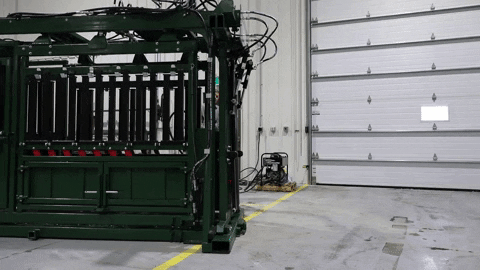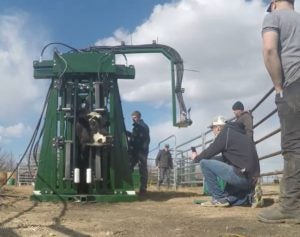A look at the features you need to consider in a heavy-duty hydraulic chute
When it comes to heavy-duty hydraulic chutes, producers often look at weight and weight alone. While it is an important component of a high-end hydraulic chute, the weight is not the be-all, end-all component that needs to be considered for large cattle operations.
The name heavy-duty itself can be misleading. It is easy to tie the term to meaning heavy weight and lots of steel and to feel pressured into putting the rest of your processing needs on the back burner. Feedlots and large cattle operations often sacrifice the features they truly need for a chute that will eliminate downtime, but there are new options available that give producers the reliability they need without sacrificing any features that make their jobs easier.
These are the four other components that should be considered when purchasing a hydraulic cattle chute, especially one that will see large numbers of cattle every year.
1. Squeeze Functionality
Many hydraulic chutes on the market are only available with a V-Squeeze, and require manual adjustments on the floor to handle smaller livestock. Not only is this a problem for obtaining the proper flow, but manual floor adjustments can quickly become problematic due to manure and dirt build-up in the chute.
Look for a hydraulic chute with a live floor included as a standard feature. In addition, consider the benefits of having the option of a parallel squeeze. This is highly beneficial for large bulls and wide mamas who may be reluctant to enter a chute that is narrow at the bottom because it can throw off their balance.
2. Cattle Access
Heavy-duty cattle chutes often sacrifice access in the name of durability. Many heavy-duty hydraulic chute models available to feedlots and cattle producers offer minimal access, making it difficult for producers and veterinarians to complete their management tasks efficiently.
Consider a chute that offers parallel access on both sides of the chute and goes above and beyond to offer elements that will make processing faster. Features to look for include open access for pour-on, oversized palpation cage, and emergency exits for enhanced safety.

3. Quality of the Hydraulic Squeeze Chute Components
Too often, the “most important” element of a heavy-duty chute is the weight of the chute alone, but it takes more than just throwing steel at it to make a truly durable chute.
Quality is important in every element of the hydraulic chute — from the paint or powder coat, to the fasteners and welds used to secure every piece together. Look for a chute that is crafted with quality at the forefront, and that will make it easy to replace or repair parts when they do wear over time.
With that said, the quality of the steel is still important to consider, but it is more than just the gauge of steel and overall weight that you need to consider. Look into the quality of steel used in the construction of the chute. First-grade North American Steel is the best quality available and will ensure the longevity of your equipment, whether you’re running a few head or thousands.
4. Cattle Head Control
Stationary neck extenders can be a nightmare, causing damage to cows’ eyes and making it more difficult to secure them in the head gate properly. Neck extenders that require manual adjustments are also problematic, as handlers need to change the settings for every size of animal they process.
Hydraulic neck extenders are the most reliable head control option for a hydraulic chute, but not all are made equal. Look for neck extenders that sit flat against the head gate when not in use to ensure that you can catch the animal easily, and ones that provide wide open access to the animal’s neck without cylinders or other bars in the way.
In an area of agriculture that rarely sees updates or improvements, Arrowquip is leading the charge to bring new equipment to the industry that is designed to make ranches safer. The newest piece of cattle equipment in their lineup, The General, is a heavy-duty hydraulic chute designed to improve cattle ranches, feedlots, and operations of all sizes.

Key features of The General hydraulic cattle chute include:
- Floating Squeeze
- An industry-first floating squeeze that allows you to work the chute any way you need to, based on the temperament of your livestock.
- 3-Way Squeeze Functionality
- Exclusive 3-Way Squeeze allows the chute to be used in a V-Squeeze, Parallel Squeeze, or new A-Squeeze.
- Infinite Extension Neck Extenders
- This new, patent-pending Neck Extender design provides the best uninhibited access to the neck of the cows for faster processing, and easier head control regardless of the size of the animal you’re working, or where they are positioned in the Head Gate.
- Dramatically Improved Access
- With eight drop-down side access panels on each side, split bottom gates for semen testing or nursing calves, an XL Vet Cage, dedicated open access for pour-on, and an emergency exit that swings wide on each side of the chute, The General offers the best access of any heavy-duty hydraulic cattle chute on the market today.
- Palpation Cage, Pivoting Hydraulic Control Arm, and Split Bottom Gates Come Standard
- Why worry about choosing the features that mean the most to you when you can have it all? The General offers the most standard features available to producers, making it the best option for every operation to improve their efficiency without having to worry about add-ons or customization.
- Optional Portable Kit
- The Portable Kit features four individual hydraulic jacks that lift and lower the unit, and can be used to clean under the chute or take it from one location to the next efficiently.
Looking for a hydraulic, but not sure if The General is right for you? Consider Arrowquip’s Q-Power line, which includes the introductory hydraulic model, the Q-Power 104 Series, or the virtually silent Q-Power 107 Series for enhanced power and low-stress cattle handling.
If you would like more information on The General, download a product brochure.
Looking for more ways to improve your operation with low-stress cattle handling? Check out the Arrowquip blog for the latest in low-stress cattle handling, how to make your ranch safer, and ways to maximize your ranching profits.
This article was published on behalf of Arrowquip.


